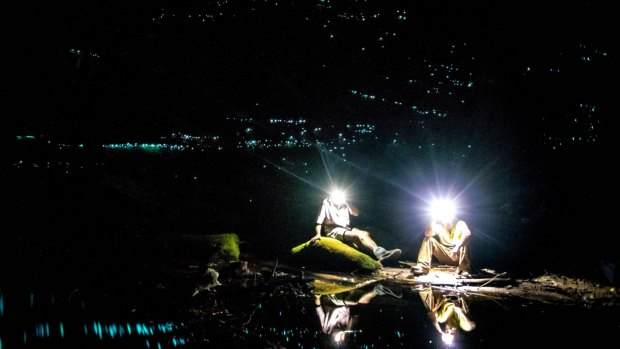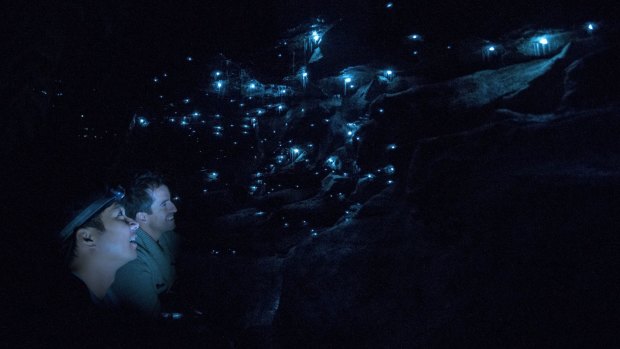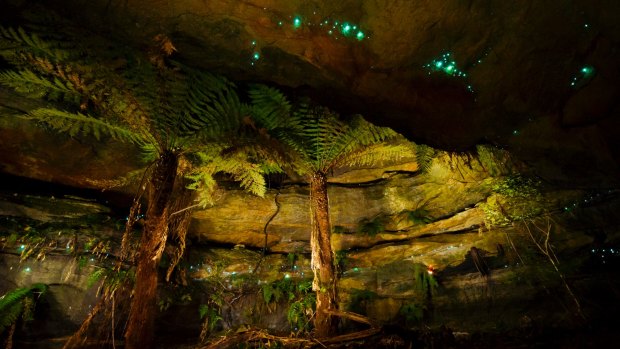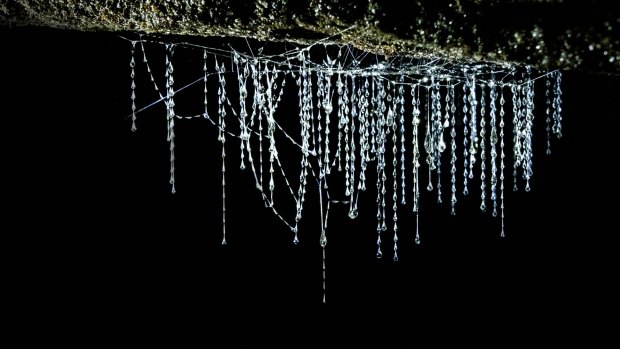This was published 7 years ago
Glow Worm Tour night walk: The Blue Mountains' secret attraction

Looking at the worms by torchlight.Credit: Brian Johnston
Glow worms have probably been glimmering on the sandstone overhang of a fern-filled gully near Berambing in the Blue Mountains for a million years. Yet they went unnoticed by local residents until one evening in 2015 when an inebriated partygoer took the wrong path home and found herself amid a wondrous galaxy of blue-green dots of light.
The fabulous find has been somewhat secret since, but property owner Jochen Spencer recently decided to share the glow worms on small-group tours. And so I find myself standing by a lonely roadside as a brisk wind tickles the trees and tosses an almost-full moon between their branches. Jochen's car looms out of the dark and crunches onto the verge. Headlights die and a dark figure emerges like a film-noir detective.
We set off uncertainly down a track, our wobbling headlamps briefly illuminating tree trunks and rocks. It's a short walk into the glow-worm gully, but you need confidence and good knee joints to negotiate the uneven and slippery surfaces in near darkness. This is no slick tourist attraction. Access is endearingly amateurish, with steps hacked out of rocks or created from a rickety assemblage of Mad Max planks held together with outsized nails. Railings look as if they'd collapse if anyone stumbled against them. Vast gumtrees are outlined against the moonlit sky, and an unseen waterfall gushes.

A whole other little world waiting to be discovered: Visitors on a glow worm tour.Credit: Brian Johnston
I'm guided as much by Jochen's voice as by my headlamp. He has certainly become well acquainted with glow worms, which he explains aren't worms at all but the name given to either flies or beetles in various parts of the world. In Australia, they're one of eight species of primitive fly called a fungus gnat, whose light is produced by a chemical reaction between oxygen in the air and enzymes and pigments in the insect's abdomen.
"The name glow worms sounds almost poetic, but actually they're larvae, and closer to maggots than worms," says Jochen. "They have a mouthful of teeth and don't do much but eat other insects – and each other."
The larvae grow for nine months before hatching gnats that only last a couple of days; they have no mouths and can't eat, but before starving lay eggs that start the bizarre cycle of life all over again. And yet these sinister-sounding gnats seem like magical faerie creatures when we first glimpse them on a rock face, glowing in a steady pale blue as if someone has draped Christmas lights along the path.

Stellar attraction: Glow worms use their light to attract mosquitoes into their webs.Credit: Getty Images
Later, we sit on rocks by the stream that runs through this gully, turn off our headlamps, and fall silent. There isn't much you can say about such a peculiar and wondrous incarnation of nature. The glow worms are constellations on the gully's sandstone, pretty in the darkness.
Across the stream, Jochen takes us up close to the bioluminescent larvae, always careful not to shine light directly at them. They're scarcely more than tiny wriggling threads, and yet their webs are impressive glittering strands like sequined curtains.
Glow worms use their light to attract midges and mosquitoes into their webs, which glitter because they're covered in sticky, light-reflecting saliva. "Glow worms have excellent hearing, and when a mosquito buzzes by can intensify their luminescence to attract it," says Jochen. "We think they glow more brightly when hungry, and can turn off their light when they've just eaten."

Glow worms seem like magical faerie creatures when we first glimpse them on a rock face.Credit: Brian Johnston
As Australia's climate continues to get drier, glow worms – which require permanently wet habitats such as rainforests or caves – have become increasingly restricted in range. They can only be easily seen in a few places such as Springbrook National Park near the Gold Coast, Morton National Park in the NSW Southern Highlands, and Great Otway National Park in Victoria.
"But the damp, sheltered canyons of the Blue Mountains are ideal, and we must suppose that many of them have glow worm populations," adds Jochen with speculative longing. "There's another whole little world out there just waiting to be discovered. Who knows where we might find them next?"
The glow worm tour starts at an address specified after booking, near Mount Tomah Botanic Gardens in the Blue Mountains, a two-hour drive from Sydney along Bells Line of Road.
STAY
Dennarque Estate in nearby Mount Wilson has three standalone, self-catering cottages. Koonawarra sleeps six and costs from $600 a night. Phone 0449 849 670, see dennarque.com
EAT
For an indulgence, local chef Cathy Armstrong caters scrumptious dinners at private accommodations from $68 a head. Phone 0404 851 990, see princesspantry.com.au
TOUR
Blue Mountains Glow Worm Tours cost $48 a person. No children under nine. Phone 0438 600 691, see glowwormtours.sydney
Brian Johnston was a guest of Australia Public Relations, Dennarque Estate and Blue Mountains Glow Worm Tours.
Sign up for the Traveller Deals newsletter
Get exclusive travel deals delivered straight to your inbox. Sign up now.